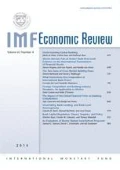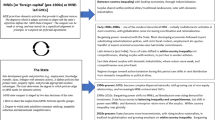Abstract
This paper addresses the efficient management of natural resource revenues in capital-scarce developing economies. It departs from usual prescriptions based on the permanent income hypothesis and argues that capital-scarce countries should prioritize domestic investment. Because revenue streams are highly volatile, governments should protect consumption from shocks by increasing it only cautiously. Volatility in domestic investment can be moderated by a buffer of international liquidity, but it is also important to structure investment processes to be able to cope efficiently with substantial fluctuations. To date, most of the resource-rich countries of Africa have not had investment rates commensurate with their rate of resource extraction.





Similar content being viewed by others
Notes
Democracy and resource rents also appear to interact badly (Collier and Hoeffler, 2009). Democracies with no natural resource rents tend to grow more rapidly than autocracies, resource-rich democracies grow more slowly than autocracies. The degree of electoral competition determines the process by which a government acquires power, whereas the number of checks and balances determine the limits on how it can use power. Electoral competition damages the democratic process, whereas checks and balances are beneficial. The evidence suggests that resource rents gradually weaken checks and balances. The governance challenge for resource-rich Africa may thus be to strengthen checks and balances in the face of pressures to weaken them.
According to this view, the only reason for it to be positive at all is the probability of human extinction and that future generations will not exist. These arguments have been re-evaluated in the context of climate change (Stern, 2006). An additional argument for using a low discount rate is that there is a probability that future generations may be much poorer than us (Weitzman, 2007).
Notice that the permanent income hypothesis holds true economic wealth (that is, resource wealth under the ground plus financial assets) constant at all dates from discovery onwards. Thus, borrowing in the early years equals the increase in the present value of resource revenue which is occurring as the windfall revenue becomes less far distant.
An implication of this result is sometimes known as the Hartwick (1977) rule. Saving the whole of the revenue from a depletable asset will (if there is no population growth or technical change) results in a constant path of consumption, that is, intertemporal egalitarianism.
And if rD=r* we return to the world of the permanent income hypothesis.
Only if the resource discovery is very large will it also be optimal to build up a permanent savings fund which will be smaller than under the permanent income hypothesis.
This section draws on Commission on Growth Development (2008).
For this calculation, we ignore the contribution to private sector investment from foreign sources. Foreign direct investment would be one category.
Note that the taxonomy links the discussion of resource revenue to that on scaling up aid (Gupta, Powell, and Yang, 2006). In IMF terminology a foreign exchange windfall is 100 percent “absorbed” if it is matched one-for-one by an increase in the nonwindfall current account deficit. Thus, cases 1 and 2 are 100 percent absorbed, case (iii) 1–(1−γ)(1−z) absorbed, and case 4 zero percent absorbed. A windfall is 100 percent ‘spent’ if it is matched one-for-one with the nonwindfall fiscal deficit. Thus, alternatives 1 and 2 are 100 percent spent, while alternatives 3 and 4 are 0 percent “spent.” Each of these alternatives has wider implications for the economy as a whole.
Note that rent grabbing as a result of higher commodity prices is especially true for capital-intensive mineral sectors such as oil, gas or diamonds, but not so for labor-intensive resource sectors such as coffee, rice or banana where the higher prices lead to higher wages and more productive activity (cf. Bó and Bó, 2009).
They let the welfare loss of public spending be given by a quadratic, so that marginal benefit of spending declines and beyond a certain level (say, 40 percent of nonoil GDP) becomes negative.
If the interest rate and rate of time preferences are zero and the utility function displays constant absolute risk aversion, then a back of the envelope calculation shows that the optimal share of windfall revenue to save is ɛυ2/2, where ɛ is the coefficient of relative risk aversion and υ the coefficient of variation of oil prices. The 95 percent confidence interval for the predicted oil prices of Hamilton (2008) suggest mean oil price of $137 per barrel and a standard deviation of $37.5, so that υ=0.27 over a one-year period. Given that a reasonable range for ɛ is 1−2, it is optimal to save between 3.75 and 7.5 percent of the windfall. If the windfall is expected to last much longer than a year, oil prices are much more unpredictable as the coefficient of variation increases with the square root of the length of the forecast period, so it is optimal to have a larger share of the windfall as a precautionary buffer. In an intertemporal context, the size of the precautionary buffers will have to be larger the more persistent shocks to commodity prices are; furthermore prudence requires that oil depletion becomes much more aggressive, especially if the country has substantial monopoly power on international resource markets and attaches high priority to boosting public spending, thus departing from the usual Hotelling rule (Ploeg, 2009).
The IMF has amended its standard permanent income guidelines for the nonhydrocarbon primary deficit of oil/gas-producing countries to allow for habit persistence in public spending on final goods. This has been applied to calculate fiscal benchmarks for Gabon (Leigh and Olters, 2006) and, more generally, for sub-Saharan African oil/gas-producing countries (Olters, 2007).
References
Akitoby, B., and T. Stfratmann, 2008, “Fiscal Policy and Financial Markets,” Economic Journal, Vol. 118, No. 533, pp. 1971–1985.
Arezki, R., and F. van der Ploeg, 2008, “Can the Natural Resource Curse be Turned into a Blessing? Role of Trade Policies and Institutions,” IMF Working Paper 07/55 (Washington, International Monetary Fund).
Barnett, S., and R. Ossowski, 2003, “Operational Aspects of Fiscal Policy in Oil-Producing Countries,” in Fiscal Policy Formulation and Implementation in Oil-Producing Countries, ed. by J. Davis, R. Ossowski, and A. Fedelino (Washington, International Monetary Fund).
Barro, R.J., 1979, “On the Determination of the Public Debt,” Journal of Political Economy, Vol. 87, No. 5, pp. 940–971.
Beetsma, R.M.W.J., and F. van der Ploeg, 2008, “Partisan Public Investment and Debt Biases: Liquidity of Government Assets and the Case for Fiscal 233046676Restrictions,” (unpublished).
Bjerkholt, O., 2002, “Fiscal Rule Suggestions for Economies with Nonrenewable Resources,” (unpublished; Norway, University of Oslo).
Bó, E.D., and P.D. Bó, 2009, “Workers, Warriors, and Criminals: Social Conflict in General Equilibrium,” (unpublished; US, Brown Uiversity).
Bornhorst, F., S. Gupta, and J. Thornton, 2008, “Natural Resource Endowments, Governance, and the Domestic Revenue Effort: Evidence from a Panel of Countries,” IMF Working Paper 08/170 (Washington, International Monetary Fund).
Brautigam, D., O.-H. Fjeldstad, and M. Moore, 2008, Taxation and State Building in Developing Countries (Cambridge, U.K., Cambridge University Press).
Collier, P., and B. Goderis, 2007, “Prospects for Commodity Exporters: Hunky Dory or Humpty Dumpty?” World Economics, Vol. 8, No. 2, pp. 1–15.
Collier, P., and B. Goderis, 2008, “Commodity Prices, Growth and the Natural Resource Curse: Reconciling a Conundrum,” (unpublished; Oxford, Centre for the Study of African Economies, University of Oxford).
Collier, P., and A. Hoeffler, 2009, “Testing the Neocon Agenda: Democracy in Resource–Rich Societies,” European Economics Review, forthcoming.
Commission on Growth Development, 2008, Growth Report: Strategies for Sustained Growth and Inclusive Development (Washington, World Bank).
Corden, M., and P. Neary, 1982, “Booming Sector and De-Industrialization in a Small Open Economy,” Economic Journal, Vol. 92, pp. 825–848.
Davis, J., R. Ossowski, J. Daniel, and S. Barnett, 2002, Stabilization and Savings Funds for Non-Renewable Resources: Experience and Fiscal Policy Implications, IMF Occasional Paper No. 205 (Washington, International Monetary Fund).
Gelb, A., and S. Grasmann, 2008, “Confronting the Oil Curse,” (unpublished; Washington, World Bank).
Glazer, A., 1989, “Politics and the Choice of Durability,” American Economic Review, Vol. 79, No. 5, pp. 1207–1213.
Gupta, S., R. Powell, and Y. Yang, 2006, Macroeconomic Challenges of Scaling Up Aid to Africa. A Check List for Practitioners (Washington, International Monetary Fund).
Hamilton, J.D., 2008, “Understanding Crude Oil Prices,” (unpublished; San Diego, Ca, University of San Diego).
Hartwick, J., 1977, “Intergenerational Equity and the Investing of Rents from Exhaustible Resources,” American Economic Review, Vol. 67, No. 5, pp. 972–974.
Hotelling, H., 1931, “The Economics of Exhaustible Resources,” Journal of Political Economy, Vol. 39, No. 2, pp. 137–175.
Leigh, D., and J.-P. Olters, 2006, Natural Resource Depletion, Habit Formation, and Sustainable Fiscal Policy: Lessons from Gabon, IMF Working Paper 06/193 (Washington, International Monetary Fund).
Mehlum, H., K. Moene, and R. Torvik, 2006, “Institutions and the Resource Curse,” Economic Journal, Vol. 116, No. 508, pp. 1–20.
Olters, J.-P., 2007, “Old Curses, New Approaches? Fiscal Benchmarks for Oil-Producing Countries in Sub-Saharan Africa,” IMF Working Paper 07/107 (Washington, International Monetary Fund).
Ossowski, R., M. Villafuerte, P.A. Medas, and T. Tomas, 2008, Managing the Oil Revenue Boom: The Role of Fiscal Institutions, IMF Occasional Paper 260 (Washington, International Monetary Fund).
Ploeg, F. van der, 2008, “Challenges and Opportunities for Resource Rich Economies,” Oxcarre Research Paper 2008-05 (University of Oxford).
Ploeg, F. van der, 2009, “Aggressive Oil Extraction and Precautionary Saving: Coping with Volatility,” Oxcarre Research Paper 2009-21 (University of Oxford).
Ploeg, F. van der, and S. Poelhekke, 2009, “Volatility and the Natural Resource Curse,” Oxford Economic Papers (University of Oxford).
Ploeg, F. van der, and A.J. Venables, 2009, “Harnessing Windfall Revenues in Developing Economies: Optimal Policies for Developing Economies,” Oxcarre Research Paper (University of Oxford).
Robinson, J.A., and R. Torvik, 2005, “White Elephants,” Journal of Public Economics, Vol. 89, Nos. 2–3, pp. 197–210.
Sachs, J.D., 1981, “The Current Account and Macroeconomic Adjustment in the 1970s,” Brookings Papers on Economic Activity: 1 (Washington, The Brookings Institution), pp. 201–268.
Sachs, J.D., and A.M. Warner, 1997, “Natural Resource Abundance and Economic Growth,” in Leading Issues in Economic Development, ed. by G. Meier and J. Rauch (Oxford, U.K., Oxford University Press).
Sala-i-Martin, X., and A. Subramanian, 2003, “Addressing the Natural Resource Curse: An Illustration from Nigeria,” IMF Working Paper 03/139 (Washington, International Monetary Fund).
Stern, N., 2006, Stern Review on the Economics of Climate Change (Cambridge, U.K., Cambridge University Press).
Weitzman, M., 2007, “The Stern Review on the Economics of Climate Change,” Journal of Economic Literature, Vol. 45, No. 3, pp. 703–724.
Wijnbergen van, S., 1984, “The Dutch Disease: A Disease After All?” Economic Journal, Vol. 94, No. 373, pp. 41–55.
World Bank, 2006, Where Is the Wealth of Nations? Measuring Capital for the 21st Century (Washington, World Bank).
Additional information
*Paul Collier, Rick van der Ploeg, and Anthony J. Venables are professors of economics at the University of Oxford. Michael Spence is a professor of economics at Stanford University and a Nobel Laureate in Economics. This paper was supported by the BP funded Oxford Centre for the Analysis of Resource Rich Economies and by the Centre for the Study of African Economies. The authors thank Rolando Ossowski for sharing his data on fiscal policies and hydrocarbon revenues with us, and thank Nicolas van de Sijpe for his able research assistance.



